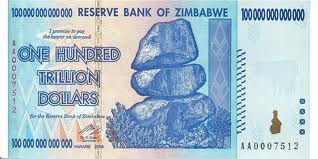We all know that the US dollar is losing value through inflation every year; in fact, the dollar has lost over 97% of its purchasing power over the last century. When “real money” (i.e. backed up with intrinsic value) was used, a cup of coffee in the 1920s costed about a few cents. In a fiat world, where money’s value is ambiguous, a cup of coffee can cost upward to a 100 trillion dollars, as was the case in Zimbabwe in recent times. Just how much more can the remaining 3% be debased from the US dollar, and how fast can it happen?
A slow, gradual decline can occur without any one person ever even noticing the effects– until, that is, a “black swan”event comes along and triggers the psychology of investors to quickly reverse their thinking, and here a collapse can literally happen overnight. A “black swan,” a term coined by Nassim Nicholas Taleb in his bestselling book The Black Swan, is “an event, positive or negative, that is deemed improbable yet causes massive consequences.” In his book he describes the psychology biases that makes people individually and collectively blind to a rare event. He also notes that the more complex a system is, the more prone it is to failure as there is more room for glitches and errors. This analogy can be used to describe the complexity of the US global empire, complete with its massive debt and 900 military bases around the world. This article is taking a “black swan” approach to the US dollar.
Here are nine events that could trigger a black swan event that would result in a US dollar collapse. The reasons below are not in order of importance, and all them can prove to be negative for the US dollar.
1. The Fed Chooses to engage in currency wars by being the spender of last resort and printing money to oblivion
When people think of a collapse, they often think of a deflationary setting. But a collapse can also occur when the face value of the currency goes up–or skyrockets upwards, as did the currency in Zimbabwe, when everyone was suddenly eligible to be a “trillionaire.” (Webster needs to update their dictionary with this word). When the face value of a currency skyrockets, the purchasing power decreases, and these are usually the ingredients for hyperinflation and collapse.
It took the US 200 years to issue $3 trillion dollar in M3 money supply. Greenspan increased this to $10 trillion dollars in his eighteenth year as Fed chairman. How much has it increased under Ben Bernanke, in his seven years as chairman of the Fed? Your guess is as good as mine, actually, because the exact number is unknown: the Fed no longer reports this statistic as of 2006, exactly when Bernanke entered office. What a coincidence!
With QE 3 and QE 4, the Fed now prints a total of $85 billion a month, most of which is reportedly being held in reserves. Even with these rock bottom low interest rates, credit demand is weak. There is plainly too much uncertainty.
If the stock market were to crash again as it did in 2008, and the Fed were to consequently launch QE5, then QE6 and so on… This would hardly be, in reality, a “black swan” event since it is probable, but nevertheless, it could eventually lead to hyper-inflation and a total collapse of the dollar, where people would lose purchasing power of the dollar as in the case of Zimbabwe. This is more likely to occur if the US dollar also loses its reserve currency status.
2. The Fed’s printing press “jams” and ceases to stops printing money
As I’ve stated before, the Fed will most likely not stop printing money. During the December 2012 FOMC meeting, this belief was supported. The most important reason why the Fed needs to continue printing money is so that it can hold interest rates artificially low to stimulate the economy. Normally, higher interest rates would increase the value of the dollar, as this would cause people to deleverage from investments and increase the demand for dollars. However, the structural imbalances the economy has undertaken from a decade of artificial low interest rates would implode the economy from high interest rates now. Undoubtedly, if the Fed stops printing money, this will mostly cause higher interest rates. This will lead to increased bankruptcies, higher unemployment, more foreclosures, lower tax revenue for the US government, and increased interest on the national debt. In this situation it could lead to the bankruptcy of the US as they could default on their own debt.
Interest rates in the 80’s were increased signficantly to kill inflation, however the US debt was nowhere near what it is today (even in terms of % of GDP). At the present moment, the US is paying over $1 billion a day just in interest payments to service its debt. A slight increase in interest rates would significantly increase these payments and leave the US with even more debt than it already has, increasing their trillion dollar per year deficits. This is a scenario whereby the US could default just as Argentina did in the early 2000’s.
If they were to stop printing money, the Fed could trigger a dollar collapse, especially if foreigners decide to no longer lend the US any more money, and start dumping US debt from their foreign reserves.
3. Rise of “Gotham City” and the Vigilantes
We know that the US is currently the largest debtor nation in the history of the world, operating on yearly trillion dollar deficits. What if the US citizens were to “wake up” and collectively stop paying their taxes? What if they were to collectively choose to no longer support political decisions that serve to perpetually increase the debt? An increase in debt ruins the prospects for future generations, after all. Taxes are essentially the life-line of any government. A cut on this life-line is like cutting the main artery to the heart. Without a tax base, government can no longer pay its bills.
A significant internal revolution by citizens would entail a collective refusal against the paying of taxes and the continual raising of the debt ceiling. Perhaps these citizens might even become bond vigilantes and sell US bonds, especially if other countries became US bond vigilantes and sell their US bonds, as well. This would likely collapse the dollar, and send the US dollar into hyper-inflation.
4. China, the largest financier of the US debt, drops the debt bomb
The Chinese can drop the debt bomb on the US just by selling a fraction of their US treasury holdings. As of June 2012,
the Chinese owned $1.16 trillion in US debt (US government treasury bonds). Japan owns $1.11 trillion and the OPEC nations, $261 billion. In the last few years, China has been lowering their purchases of US debt and replacing it with other assets. To circumvent this problem, the Fed of late has been stepping in to purchase treasury bonds to make up for the lost demand of the foreigners.
China’s power is the direct result of the symbiotic trade relationship with the US. The US buys goods from China in US dollars, and China ships them the products and uses the US dollar surpluses to buy US debt, among other assets.
It may not be in the interest of China to drop the debt bomb, but it definitely has the power to do it. If this is the case, there would be so much US debt on the market that other US debt holding countries could also throw their debt on the market as well as a result of panic and fear. Triggering an international run on US debt. The US Dollar will surely collapse in this scenario.
5. China, Japan, Russia, Iran, Germany, Brazil, Australia, Chile, UAE, India, and South Africa are bypassing the dollar and creating bi-lateral trade warfare.
What if now the Chinese, instead of dropping the debt bomb, create enough bi-lateral trade agreements to avoid the US dollar altogether with foreigners? In fact China, among other countries, has already done this by trading with the Chinese Yuan instead of the US dollar. If China, Japan, Russian, Iran, Germany, Brazil, Australia, Chile, USE, India, and South Africa would continue to do so, other larger countries may follow suit and before you know it, the majority of trade would be transacted in non-US dollars. At this point, the US dollar would no longer be needed, and its world reserve currency status would collapse along with its purchasing power.
What could also trigger a large decline in the US dollar would be if a relatively large oil-producing country (like Saudi Arabia) refuses to use the US dollar to sell its oil, choosing instead something more tangible (like gold). William R. Clark’s excellent book, Petrodollar Warfare, treats this issue precisely, going in depth into the Petrodollar collapse and how the US maintains its dollar supremacy with its current imperialistic foreign policy. If a major OPEC nation refuses to sell its oil in US dollars, this could result in a total loss of confidence in the US dollar, precipitating its collapse.
6. “Good-bye Dollar, Hello SDR!” The U.N. and IMF implement a New World Reserve Currency
George Soros states in a recent video interview (see here) that the US needs a “New Financial World Order,” on the pretext that the current system is “broke” and creating huge trade imbalances. The Guardian stated the following:
“The International Monetary Fund warned that the colossal United States trade deficit was a noose around the neck of the economy, emphasizing that the once mighty dollar could collapse at any moment.”
Soros, a member of the Bretton Woods Committee–the same institution that created the IMF–is now promoting the Special Drawings Right (SDR) as a potential new world currency.
The progress for the SDR has been very slow and has not received much acceptance among other nations. However, note that the US currently controls the IMF by its voting powers (17% nominal interest, and a required of 85% majority for decisions). As more and more people lose confidence in the US dollar in general due to reckless monetary and fiscal policies, the IMF can instead back the SDR with gold to promote stability and confidence. That is certainly one realistic possibility considering that they reportedly own over 2,800 tons of gold. A shift in reserve currency from the US dollar to the SDR or other another currency would undoubtedly collapse the US dollar. It’s trade imbalance is sustained by it’s reserve status.
7. A “too-big-to-fail” corporation fails: A derivative shock-wave.
The Financial Stability Board (FSB) released a list of 29 “too big to fail” corporations operating around the world. According to the FSB, these banks are considered to be “systemically important financial institutions” and a failure of any one of these corporations could result in “financial systemic failure.” Of the 29 corporations on the list, 17 are based in Europe, eight in the U.S., and four in Asia.
A failure of any one of these banks, but especially one in the US, could create a bank run, further destroying the ability to provide credit and increasing the likelihood of a dollar collapse.
What is most likely to create a bank failure is a derivative failure. Actually, a current derivatives scandal is threatening to take down the world’s oldest bank:
“Banca Monte dei Paschi di Siena, the world’s oldest bank, was making loans when Michelangelo and Leonardo da Vinci were young men and before Columbus sailed to the New World. The bank survived the Italian War, which saw Siena’s surrender to Spain in 1555, the Napoleonic campaign, the Second World War and assorted bouts of plague and poverty.
But MPS may not survive the twin threats of a gruesomely expensive takeover gone bad and a derivatives scandal that may result in legal action against the bank’s former executives. After five centuries of independence, MPS may have to be nationalized as its losses soar and its value sinks.”
The precise, total amount of global derivatives in the market is not exactly known, but estimates range from 650 trillion to 1.5 quadrillion dollars. This amount dwarfs the world’s GDP at approximately $70 trillion. (Refer to this article to see what $16 trillion looks like.) It is no wonder why Warren Buffet calls derivatives the “financial weapons of mass destruction.”
According to the Controller of Currency and National Banks, here are the stats for the following banks as of September 2012:
JPMorgan Chase
Total Assets: $1.85 trillion dollars
Total Exposure To Derivatives: $71.07 trillion dollars
Citibank
Total Assets: $1.365 trillion dollars
Total Exposure To Derivatives: $55.51 trillion dollars
Bank Of America
Total Assets: $1.448 trillion dollars
Total Exposure To Derivatives: $43.79 trillion dollars
Goldman Sachs
Total Assets: $120.43 billion (not trillion)
Total Exposure To Derivatives: $41,23 trillion
Note that JP Morgan alone has more derivative exposure than the world’s GDP. A derivative collapse is definitely an event that could take down the whole financial system and collapse the US dollar.
8. A run on the gold and silver bullion exchanges
Andrew McGuire, a former Goldman Sachs trader, disclosed that the London bullion Market Association (LBMA) trades on a net basis each year of $5.4 trillion dollars, a little less than half the size of the US economy. The LBMA is the biggest gold commodity market in the world.
But how can the LBMA do this be when the gold market is such a tiny market? The world production of gold is about 2,500 metric tons of gold (88,184,905 oz) which at today’s price of $1,667 is approximately $147 billion in yearly production value.
The LBMA is the equivalent of a fractional reserve system in that it is leveraged 100 to 1. For every ounce of real gold that is sold, 100 ounces of paper gold is sold, meaning there are 100 claims on each and every ounce of gold. These numbers were verified by Jeffrey Christian, a gold expert and founder of CMP Group (a commodities research, consulting, investment banking, and asset management company). The leverage is absurd.
The LBMA can be compared with other exchanges. The world’s gold market is backed up by approximately 2.3% of real gold. If a mere 2.5% of people would start demanding their gold, the physical gold market would explode, subsequently crushing the dollar, as the value of the dollar is inversely proportional to the price of gold.
Hedge fund manager Kyle Bass pointed out that the New York Comex has only approximately 3% of the bullion on hand to cover future contracts positions. and this game will continue if people do not demand delivery of their gold. The emperor has no clothes!
9. A central bank gold rush and foreign gold repatriation from the Fed – Gold Audit
Venezuela has actually just recently received their last shipment of gold bars from the US.
“This was the largest type of operation to transport this type of metal in the last fifteen years,” said Merentes. “The repatriation of our gold was an act of financial prudence and sovereignty.” (Bloomberg)
The Germans and the Dutch have also recently requested their gold to be repatriated from the US. However, unlike Venezuela, Germany was told to wait seven years to get their gold back. That sounds odd, right?
Now the Swiss, under their recently launched Swiss Initiative to Secure the Swiss National Bank’s Gold Reserves, are hinting that they might want to get their gold back on Swiss soil. The Swiss government has a long standing tradition of backing their currency with gold.
This gold repatriation is turning out to be much bigger than a political statement. It is a total non-compliant/non-confidence vote for the US and the US dollar.
Which country is next? Mexico? They have 96% of their gold stored in the US and London.
A central bank gold rush to repatriate a country’s gold from the US can cause a huge upward demand for gold, pushing the price of gold upward and crushing the US dollar. (Especially if the Fed doesn’t have their gold and has been leased out into the market)
We have just gone through nine black swan events–events, remember, that are highly improbable but yet, when they do happen, have massive consequences. In Part 2 of this article, we will go through four other “black swan” events that could cause the US dollar to collapse.
References
http://en.wikipedia.org/wiki/Too_big_to_fail
http://www.silverdoctors.com/bank-of-mexico-admits-96-of-gold-reserves-held-in-us-london/
http://www.zerohedge.com/news/2013-01-16/all-aboard-gold-repatriation-train-first-germany-next-netherlands
http://www.bloomberg.com/news/2012-01-31/venezuela-receives-last-shipment-of-repatriated-gold-bars-1-.html




